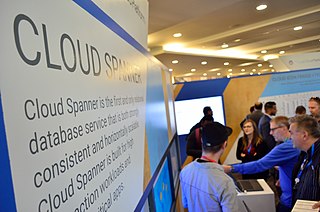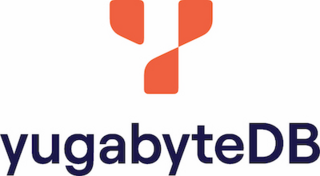
MySQL is an open-source relational database management system (RDBMS). Its name is a combination of "My", the name of co-founder Michael Widenius's daughter My, and "SQL", the acronym for Structured Query Language. A relational database organizes data into one or more data tables in which data may be related to each other; these relations help structure the data. SQL is a language that programmers use to create, modify and extract data from the relational database, as well as control user access to the database. In addition to relational databases and SQL, an RDBMS like MySQL works with an operating system to implement a relational database in a computer's storage system, manages users, allows for network access and facilitates testing database integrity and creation of backups.

Spencer Kimball is an American computer programmer, entrepreneur, and business executive. He is the CEO of Cockroach Labs, a company he co-founded in 2014. His work as a programmer includes creating GNU Image Manipulation Program (GIMP) while still in college, and assisting the source code development of CockroachDB, the namesake software of Cockroach Labs. In addition to Cockroach Labs, Kimball was involved in the founding of other tech startups including WeGo and Viewfinder.

Peter Mattis is an American computer programmer, entrepreneur, and business executive. He is the CTO and co-founder for Cockroach Labs, a company he co-founded in 2014. His work as a programmer includes launching GNU Image Manipulation Program (GIMP) while still in college, and assisting the source code development of CockroachDB, the namesake software of Cockroach Labs.
An embedded database system is a database management system (DBMS) which is tightly integrated with an application software; it is embedded in the application. It is a broad technology category that includes:
Redis is a source-available, in-memory storage, used as a distributed, in-memory key–value database, cache and message broker, with optional durability. Because it holds all data in memory and because of its design, Redis offers low-latency reads and writes, making it particularly suitable for use cases that require a cache. Redis is the most popular NoSQL database, and one of the most popular databases overall. Redis is used in companies like Twitter, Airbnb, Tinder, Yahoo, Adobe, Hulu, Amazon and OpenAI.

MariaDB is a community-developed, commercially supported fork of the MySQL relational database management system (RDBMS), intended to remain free and open-source software under the GNU General Public License. Development is led by some of the original developers of MySQL, who forked it due to concerns over its acquisition by Oracle Corporation in 2009.

The open-core model is a business model for the monetization of commercially produced open-source software. The open-core model primarily involves offering a "core" or feature-limited version of a software product as free and open-source software, while offering "commercial" versions or add-ons as proprietary software. The term was coined by Andrew Lampitt in 2008.
A cloud database is a database that typically runs on a cloud computing platform and access to the database is provided as-a-service. There are two common deployment models: users can run databases on the cloud independently, using a virtual machine image, or they can purchase access to a database service, maintained by a cloud database provider. Of the databases available on the cloud, some are SQL-based and some use a NoSQL data model.

Basho Technologies was a distributed systems' company that developed a key-value NoSQL database technology, Riak, and an object storage system built upon the Riak platform, called Riak CS.

Spanner is a distributed SQL database management and storage service developed by Google. It provides features such as global transactions, strongly consistent reads, and automatic multi-site replication and failover. Spanner is used in Google F1, the database for its advertising business Google Ads, as well as Gmail and Google Photos.
NewSQL is a class of relational database management systems that seek to provide the scalability of NoSQL systems for online transaction processing (OLTP) workloads while maintaining the ACID guarantees of a traditional database system.
Aerospike Database is a real-time, high performance NoSQL database. Designed for applications that cannot experience any downtime and require high read & write throughput. Aerospike is optimized to run on NVMe SSDs capable of efficiently storing large datasets. Aerospike can also be deployed as a fully in-memory cache database. Aerospike offers Key-Value, JSON Document, and Graph data models. Aerospike is open source distributed NoSQL database management system, marketed by the company also named Aerospike.

Redis Ltd. is an Israeli private computer software company headquartered in Mountain View, California. Redis is the sponsor of the source-available in-memory NoSQL database of the same name and the provider of Redis Enterprise software, cloud services, and tools for global companies. The company’s research and development center is based in Tel Aviv and it has additional offices in London, Austin, and Bengaluru.
WebScaleSQL was an open-source relational database management system (RDBMS) created as a software branch of the production-ready community releases of MySQL. By joining efforts of a few companies and incorporating various changes and new features into MySQL, WebScaleSQL aimed toward fulfilling various needs arising from the deployment of MySQL in large-scale environments, which involve large amounts of data and numerous database servers.

Ben Darnell is an American computer programmer, entrepreneur, and business executive. He is the chief technology officer for Cockroach Labs, a company he co-founded in 2015. Prior to his work at Cockroach Labs, he worked for tech companies that include FriendFeed, Facebook, Brizzly, Dropbox, Viewfinder, and Square, Inc.
TiDB is an open-source NewSQL database that supports Hybrid Transactional and Analytical Processing (HTAP) workloads. Designed to be MySQL compatible, it is developed and supported primarily by PingCAP and licensed under Apache 2.0. It is also available as a paid product. TiDB drew its initial design inspiration from Google's Spanner and F1 papers.
A distributed SQL database is a single relational database which replicates data across multiple servers. Distributed SQL databases are strongly consistent and most support consistency across racks, data centers, and wide area networks including cloud availability zones and cloud geographic zones. Distributed SQL databases typically use the Paxos or Raft algorithms to achieve consensus across multiple nodes.

YugabyteDB is a high-performance transactional distributed SQL database for cloud-native applications, developed by Yugabyte.










